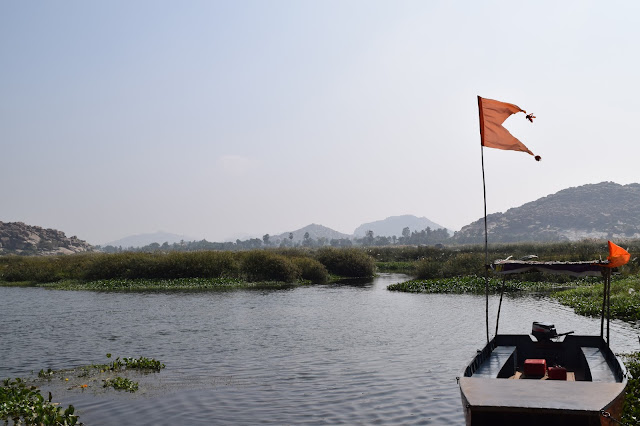The Virupaksha Temple (above) was built on the command of
Lakkana Dandesha who was a chieftain under Deva Raya II. The temple has three gopurams
and the major deity of the temple is Virupaksha, who is a form of Shiva. Other
than Virupaksha there is also a shrine dedicated to Pampadevi who is said to
his spouse.
The temple is always buzzing with crowds throughout the week; there are families who worship Virupaksha, often come for pilgrimage purposes. They take dip in the river of Tungabhadra, walk till the temple and offer their prayers, dry their clothes and have food. You could also find men who were Anjaneya followers, there on pilgrimage for the 41 day fast for Lord Anjaneya also known as Lord Hanuman.
There are large signboards the moment you enter into the temple giving instructions in Kannada. There is a price of 2 rupees per head to enter the temple for Indians while for foreigners it is 500 per head. In order to shoot pictures, you need to pay 50 rupees and before entering the temple you can see stalls selling things required to conduct rituals as well as small souvenirs for tourists. Once you enter the temple you can see how busy people are taking out their cell phones to click snaps of the place and take selfies with the background of the temple. On the left side is a mantapa where there is an elephant. Elephants are considered an important part of the Hindu religion. But here, people can be seen simply crowding around the elephant to get a picture or a touch. It makes one wonder if they know its true importance. The entire atmosphere is not that of a place for worship rather than just another monument for tourists.
You can see people go inside the main temple, where the deity is kept and photography is prohibited. There are always large crowds trying to get a glance of the idol of Lord Virupaksha. You barely get to spend a minute and pray and get prasad before you are pushed out of the temple.
This very clearly shows the increasing commercialisation that has been taking place in Hampi for the past few years. The sacred place is gradually losing it's essence as a pilgrimage place and becoming more of just another tourist spot.
The temple is always buzzing with crowds throughout the week; there are families who worship Virupaksha, often come for pilgrimage purposes. They take dip in the river of Tungabhadra, walk till the temple and offer their prayers, dry their clothes and have food. You could also find men who were Anjaneya followers, there on pilgrimage for the 41 day fast for Lord Anjaneya also known as Lord Hanuman.
There are large signboards the moment you enter into the temple giving instructions in Kannada. There is a price of 2 rupees per head to enter the temple for Indians while for foreigners it is 500 per head. In order to shoot pictures, you need to pay 50 rupees and before entering the temple you can see stalls selling things required to conduct rituals as well as small souvenirs for tourists. Once you enter the temple you can see how busy people are taking out their cell phones to click snaps of the place and take selfies with the background of the temple. On the left side is a mantapa where there is an elephant. Elephants are considered an important part of the Hindu religion. But here, people can be seen simply crowding around the elephant to get a picture or a touch. It makes one wonder if they know its true importance. The entire atmosphere is not that of a place for worship rather than just another monument for tourists.
You can see people go inside the main temple, where the deity is kept and photography is prohibited. There are always large crowds trying to get a glance of the idol of Lord Virupaksha. You barely get to spend a minute and pray and get prasad before you are pushed out of the temple.
This very clearly shows the increasing commercialisation that has been taking place in Hampi for the past few years. The sacred place is gradually losing it's essence as a pilgrimage place and becoming more of just another tourist spot.
























